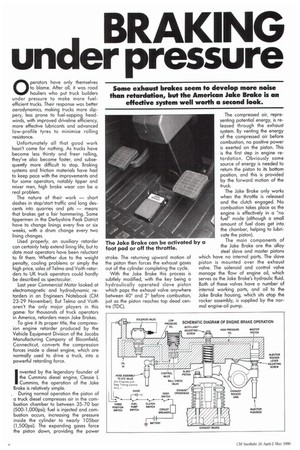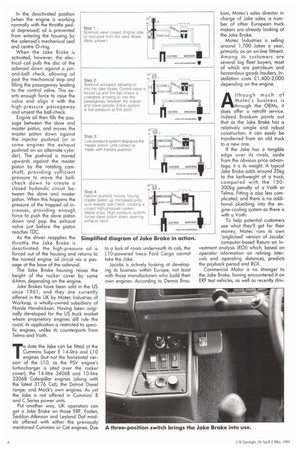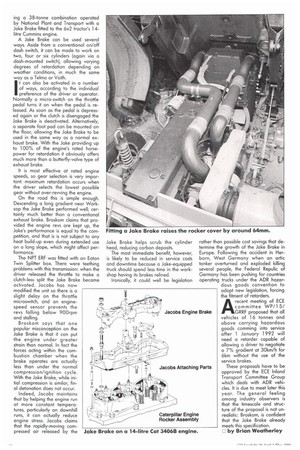BRAKING
Page 52

Page 54

Page 56

If you've noticed an error in this article please click here to report it so we can fix it.
under pressure
Some exhaust brakes seem to develop more noise than retardation, but the American Jake Brake is an effective system well worth a second look.
Operators have only themselves to blame. After all, it was road hauliers who put truck builders under pressure to make more fuelefficient trucks. Their response was better
aerodynamics, making trucks more slip pery, less prone to fuel-sapping headwinds, with improved driveline efficiency, more effective lubricants and advanced low-profile tyres to minimise rolling resistance.
Unfortunately all that good work hasn't come for nothing. As trucks have become less thirsty and freer rolling, they've also become faster, and subsequently more difficult to stop. Braking systems and friction materials have had to keep pace with the improvements and for some operators, notably tipper and mixer men, high brake wear can be a real problem.
The nature of their work — short dashes in stop/start traffic and long des cents into quarries and pits — means that brakes get a fair hammering. Some tippermen in the Derbyshire Peak District have to change linings every five or six weeks, with a drum change every two lining changes.
Used properly, an auxiliary retarder can certainly help extend lining life, but to date most operators have been reluctant to fit them. Whether due to the weight penalty, cooling problems or simply the high price, sales of Telma and Voith retarders to UK truck operators could hardly be described as spectacular.
Last year Commercial Motor looked at electromagnetic and hydrodynamic re tarders in an Engineers Notebook (CM 23-29 November). But Telma and Voith aren't the only major players in this game: for thousands of truck operators in America, retarders mean Jake Brakes.
To give it its proper title, the compression engine retarder produced by the Vehicle Equipment Division of the Jacobs Manufacturing Company of Bloomfield, Connecticut, converts the compression forces inside a diesel engine, which are normally used to drive a truck, into a powerful retarding force.
Invented by the legendary founder of the Cummins diesel engine, Clessie L Cummins, the operation of the Jake Brake is relatively simple.
. During normal operation the piston of a truck diesel compresses air in the combustion chamber to between 35-70 bar (500-1,000psi); fuel is injected and combustion occurs, increasing the pressure inside the cylinder to nearly 105bar (1,500psi). The expanding gases force the piston down, providing the power stroke. The returnmg upward motion of the piston then forces the exhaust gases out of the cylinder completing the cycle.
With the Jake Brake this process is subtlely modified, with the key being a hydraulically operated slave piston which pops the exhaust valve anywhere between 40 and 2 before combustion, just as the piston reaches top dead centre (TDC). The compressed air, representing potential energy, is released through the exhaust system. By venting the energy of the compressed air before combustion, no positive power is exerted on the piston. This is the first step in engine retardation. Obviously some source of energy is needed to return the piston to its bottom position, and this is provided by the forward motion of the truck.
The Jake Brake only works when the throttle is released and the clutch engaged. No combustion takes place as the engine is effectively in a "no fuel" mode (although a small amount of fuel does get into the chamber, helping to lubricate the piston).
The main components of the Jake Brake are the alloy steel slave and master pistons which have no internal parts. The slave piston is mounted over the exhaust valve. The solenoid and control valve manage the flow of engine oil, which serves as the Jake Brake's hydraulic fluid. Both of these valves have a number of internal working parts, and oil to the Jake Brake housing, which sits atop the rocker assembly, is supplied by the normal engine-oil pump.
In the deactivated position (when the engine is working normally with the throttle pedal depressed) oil is prevented from entering the housing by the solenoid's mechanical seal and centre 0-ring.
When the Jake Brake is activated, however, the electrical coil pulls the disc of the solenoid down against a pinand-ball check, allowing oil past the mechanical stop and filling the passageway leading to the control valve. This exerts enough force to raise the valve and align it with the high-pressure passageway and unseat the ball-check.
Engine oil then fills the passage between the slave and master piston, and moves the master piston down against the injector pushrod (or in some engines the exhaust pushrod on an alternate cylinder). The pushrod is moved upwards against the master piston by the rotating camshaft, providing sufficient pressure to move the ballcheck down to create a closed hydarulic circuit between the slave and master piston. When this happens the pressure of the trapped oil increases, providing enough force to push the slave piston down and pop the exhaust valve just before the piston reaches TDC.
As the driver reapplies the throttle the Jake Brake is
deactivated: the high-pressure oil is forced out of the housing and returns to the normal engine oil circuit via a passage at the base of the solenoid.
The Jake Brake housing raises the height of the rocker cover by some 64mm, depending on the engine.
Jake Brakes have been sold in the US since 1961, and they are currently offered in the UK by Motec Industries of Worksop, a wholly-owned subsidiary of Norde Hendrickson. Having been originally developed for the US truck market where proprietary engines still rule the roost, its application is restricted to specific engines, unlike its counterparts from Telma and Voith.
To date the Jake can be fitted ot the Cummins Super E 14-litre and 110 engines (but not the horizontal version of the L10, as the PSV engine's turbocharger is sited over the rocker cover), the 14-litre 34068 and 10-litre 3306B Caterpillar engines (along with the latest 31 76 Cat); the Detroit Diesel range; and Mack's own engines. As yet the Jake is not offered in Cummins' B and C Series power units.
Put another way, UK operators can get a Jake Brake on those ERF, Foden, Seddon Atkinson and Leyland Daf models offered with either the previously mentioned Cummins or Cat engines. Due to a lack of room underneath its cab, the 110-powered Iveco Ford Cargo cannot take the Jake.
Jacobs is actively looking at developing its business within Europe, not least with those manufacturers who build their own engines. According to Dennis Bros kom, Motet's sales director in charge of Jake sales, a number of other European truck makers are already looking at the Jake Brake.
Motec Industries is selling around 1,700 Jokes a year, primarily as an on-line fitment. Among its customers are several big fleet buyers, most of which are petroleum and harzardous goods hauliers. Installation costs £1,400-2,000 depending on the engine.
Although much of Motec's business is through the OEMs, it does offer a retrofit service. Indeed Broskum points out that as the Jake Brake has a relatively simple and robust construction, it can easily be transferred from an old truck to a new one.
If the Jake has a tangible edge over its rivals, aside from the obvious price advantage, it is its weight. A typical Jake Brake adds around 35kg to the kerbweight of a truck, compared with the 1 50300kg penalty of a Voith or Telma. Fitting is also less complicated, and there is no additional plumbing into the engine cooling system as there is with a Voith.
To help potential customers
see what they'll get for their
money, Motec runs its own
computer-based Return on Investment analysis (ROI) which, based on operator information on relining intervals and operating distances, predicts the payback period and ROI.
Commercial Motor is no stranger to the Jake Brake, having encountered it on ERE test vehicles, as well as recently driv
ing a 38-tonne combination operated by National Plant and Transport with a Jake Brake fitted to the 6x2 tractor's 14litre Cummins engine.
A Jake Brake can be used several ways. Aside from a conventional on/off dash switch, it can be made to work on two, four or six cylinders (again via a dash-mounted switch), allowing varying degrees of retardation depending on weather conditions, in much the same way as a Telma or Voith.
it can also be activated in a number of ways, according to the individual preference of the driver or operator. Normally a micro-switch on the throttle pedal turns it on when the pedal is released. As soon as the pedal is depressed again or the clutch is disengaged the Jake Brake is deactivated. Alternatively, a separate foot pad can be mounted on the floor, allowing the Jake Brake to be used in the same way as a normal exhaust brake. With the Jake providing up to 100% of the engine's rated horsepower for retardation it obviously offers much more than a butterfly-valve type of exhaust brake.
It is most effective at rated engine speeds, so gear selection is very important: maximum retardation occurs when the driver selects the lowest possible gear without over-revving the engine.
On the road this is simple enough. Descending a long gradient near Worksop the Jake Brake performed well; certainly much better than a conventional exhaust brake. Broskom claims that provided the engine revs are kept up, the Jake's performance is equal to the competition, and that is is not subject to any heat build-up even during extended use on a long slope, which might affect performance.
Broskom says that one popular misconception on the Jake Brake is that it can put the engine under greater strain than normal. In fact the forces acting within the combustion chamber when the brake operates are actually less than under the normal compression/ignition cycle. With the Jake Brake, while initial compression is similar, final detonation does not occur.
Indeed, Jacobs maintains that by helping the engine run at more constant temperatures, particularly on downhill runs, it can actually reduce engine stress. Jacobs claims that the rapidly-moving cornpressed air released by the Jake Brake helps scrub the cylinder head, reducing carbon deposits.
The most immediate benefit, however, is likely to be reduced in service costs and downtime because a Jake-equipped truck should spend less time in the workshop having its brakes relined.
Ironically, it could well be legislation rather than possible cost savings that determine the growth of the Jake Brake in Europe. Following the accident in Herborn, West Germany when an artic tanker overturned and exploded killing several people, the Federal Repulic of Germany has been pushing for countries operating trucks under the ADR hazardous goods convention to adopt new legislation, forcing the fitment of retarders.
Arecent meeting of ECE committee WP/15/ GRRF proposed that all vehicles of 16 tonnes and above carrying hazardous goods comming into service after 1 January 1992 will need a retarder capable of allowing a driver to negotiate a 7% gradient at 30km/h for 6km without the use of the service brakes.
These proposals have to be approved by the ECE Inland Transport Committee Group which deals with ADR vehicles. It is due to meet later this year. The general feeling among industry observers is that the tirriescale and structure of the proposal is not unrealistic: Broskom, is confident that the Jake Brake already meets this specification.
by Brian Weatherley
























































































































